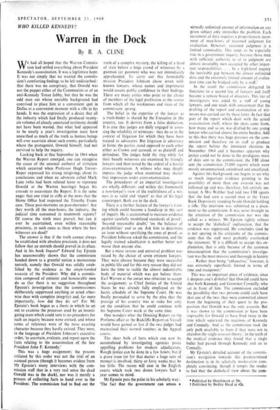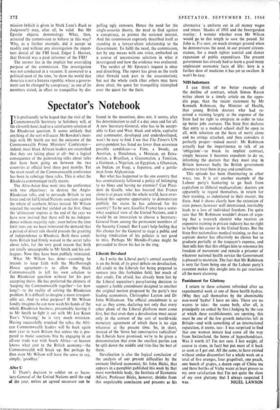Warren in the Dock
WHO KILLED KENNEDY?
By R. A. CLINE
WE had all hoped that the Warren Commis- sion had settled everything about President Kennedy's assassination. It was a legitimate hope. It was not simply that we wanted the commis- sion's comforting findings to be left undisturbed: that there was no conspiracy, that Oswald was not the puppet either of the Communists or of an anti-Kennedy Texan lobby, but that he was the odd man out whose unstable background had contrived to place him at a convenient spot in Dallas at a convenient moment with a rifle in his hands. It was the expression of a desire that all the industry which had finally produced twenty- six volumes of closely annotated testimony should not have been wasted, that what had appeared to be nearly a year's investigation must have unearthed as much of the truth as human beings will ever ascertain about such events, particularly where the protagonist, Oswald himself, had not survived to help the inquiry.
Looking back at that September in 1964 when the Warren Report emerged, one can recognise the cause of the unusual outburst of irritation which occurred when Professor Hugh Trevor- Roper expressed his strong misgivings about its conclusions and when an advocate called Mark Lane (who had been refused leave to represent Oswald at the Warren hearings) began his crusade to assassinate the Report. It is the same anger that one tried to stifle at the news that the Home Office had reopened the Timothy Evans case. These post-mortems on post-mortems! Are they worth all the man-hours, the industry, the judicial time consumed in mammoth reports? Of course the truth must prevail, but can it ever be ascertained, even within reasonable proximity, in such cases as these where the best witnesses are dead?
The answer is that if the truth cannot always be established with absolute precision, it does not follow that an untruth should prevail in its place. And in his book Inquest* Edward Jay Epstein has unanswerably shown that the commission handed down to a grateful nation a momentous untruth, namely that Oswald was solidly estab- lished by the evidence as the single-handed assassin of the President. Why did a commis- sion composed of eminent and honourable men do so (for there is no suggestion throughout Epstein's investigation that the commissioners deliberately suppressed anything or acted other- wise than with complete integrity) and, far more importantly, how did they do so? For Mr Epstein's book began as a thesis in which he set out to examine the processes used by an investi- gating team which could turn to no precedents for such an inquiry because none existed, and whose terms of reference were of the most exacting character because they hardly existed. They were, in the language of President Johnson's executive order, 'to ascertain, evaluate, and report upon the facts relating to the assassination of the late President John F. Kennedy.'
This was a huge assignment; the process initiated by this order was not the trial of an accused person (though it becomes evident from Mr Epstein's many interviews with the com- mission staff that in a very real sense the dead Oswald was in the dock), nor was it merely a process of collecting facts to hand over to the President. The commission had to find out the truth of a complex mystery, the killing of a head of state before a huge crowd of witnesses by a gunman (or gunmen) who was not immediately apprehended. To carry out this formidable mission President Johnson chose seven well- known lawyers, whose names and imprimatur would ensure public confidence in their findings. There are many critics who point to the choice of members of the legal profession as the source from which all the weaknesses and vices of the commission sprang.
The belief in the expertise of the lawyer as a truth-finder is shared by the Executive in this country, too. It derives from a false deduction. It is true that judges are daily engaged in asses- sing the reliability of witnesses: they do so in the context of litigation for which they have been trained as advocates. But litigation is adversary in form; the parties stand opposed to each other either as Crown and accused, or as plaintiff and defendant. The judges hold the ring while for their benefit witnesses are examined by friendly lawyers and then tested by the ordeal of a hostile cross-examination. A witness who may deeply impress the judge when examined may shatter that impression under cross-examination.
The procedures of an impartial investigation are wholly different; and within this framework a non-lawyer's view of the truthfulness of a wit- ness is as valid and 'expert' as that of his legal counterpart. Both are in the dark.
There is a further feature of the lawyer's train- ing which could become a handicap in this sort of inquiry. He is accustomed to measure evidence against carefully modulated standards of proof: `beyond reasonable doubt,' on the balance of probabilities' and so on. Ask him to determine an issue without specifying the onus of proof, as President Johnson asked the commission, and the legally trained adjudicator is neither better nor worse than anyone else.
But a more serious and universal problem was raised by the choice of seven eminent lawyers.
They were chosen because they were successful in public life and for this very reason they did not have the time to tackle the almost indomitable body of material which was put before them.
Earl Warren at the outset was reluctant to accept the assignment; as Chief Justice of the United States he was already fully employed on the hectic schedule of the Supreme Court. He was finally persuaded to serve by the plea that the prestige of his country was at stake but only on the condition that he could continue with his Supreme Court work at the same time.
One wonders what the Denning Report on the Profumo affair or the Radcliffe Report on Vassall would have gained or lost if the two judges had maintained their normal routines in the Appeal courts.
The sheer bulk of facts which can now be accumulated by investigating agencies poses appalling problems for modern adjudicators.
Rough justice can be done in a few hours; but if a grave issue (or for that matter a huge sum of money) is involved, thirty or forty weeks may be too little. The recent will case in the English courts which took two dozen lawyers half a year comes to mind.
Mr Epstein puts the point in his scholarly way : `The fact that the government can amass a
virtually unlimited amount of information on any given subject only intensifies the problem. Each increment of data requires a proportionate incre- ment of man-hours of reasoned judgment for evaluation. However, reasoned judgment is a limited commodity. This tends to be especially true in a government inquiry, because those men with sufficient authority to sit in judgment are almost invariably men occupied by other impor- tant responsibilities . . . In a high-level inquiry the inevitable gap between the almost unlimited data and the extremely limited amount of evalua- tion time can be bridged only by a staff.'
In the result the commission delegated its functions to a second line of lawyers and itself became a remote board of directors. This tier of investigators was aided by a staff of young lawyers, and one reads with amazement that the drafting of the report and examination of wit- nesses was carried out by these latter. In fact that part of the report which dealt with the actual assassination itself, where the shots came from, how many and so on, was drafted by one young lawyer who carried almost the entire burden. Add to this that there was huge pressure on the com- mission and therefore on its staff to produce the report before the imminent elections in November 1964 and it becomes apparent why justice could not be done to the prodigious mass of data sent to the commission; the FBI alone sent the commission 25,000 reports which were mostly unsummarised, unindexed and uncollated.
Against this background one begins to see why so much important evidence pointing to the possibility of more than one assassin was not followed up and was, therefore, left entirely un- tested. A Mrs Walther had told two FBI agents that she had seen a second man at the Texas Book Depository standing beside Oswald holding a rifle. The interview was submitted in a docu- ment to the commission. It was never brought to the attention of the commission nor was she called as a witness. Mr Epstein rightly refuses to accept the 'diabolical' explanation, that the evidence was suppressed. He concludes (and he is not sparing in his criticisms of the commis- sion) that the staff most probably overlooked the statement. 'If it is difficult to accept this ex- planation, that is only because of the common misconception that the commission's investiga- tion was the most massive and thorough in history . . . Rather than being "exhaustive," however, it was extremely superficial, limited in terms of time and manpower.'
This was an important piece of evidence, since it deepens one's disbelief that Oswald could have shot both Kennedy and Governor Connally, who sat in front of him. The commission excluded the possibility that two persons could each have shot one of the two; they were committed almost from the beginning of their quest to the pro- position that Oswald was the only assassin. But it was shown to the commission to have been impossible for Oswald to have fired twice in the time which separated the reactions of Kennedy and Connally. And so the commission took the only path available to them if they were not to abandon the single-assassin theory: in the teeth of the medical evidence •they found that a single bullet had passed through Kennedy and on to Connally.
Mr Epstein's detailed account of the commis- sion's navigation towards this predetermined destination is in its scholarly moderation com- pletely convincing, though it tempts the reader to feel that the diabolical view about the com- • Published by Hutchinson at 30s. t Published by Bodley Head at 42s.
mission (which is given in Mark Lane's Rush to Judgmentt) may, after all, be valid. But Mr Epstein abjures demonology. What, then, actuated the commission to behave in this way? Why, as a further example, did it accept so readily and without any investigation the impor- tant denial of the FBI head, Edgar J. Hoover, that Oswald was a paid informer of the FBI?
The answer lies in the implicit but overriding purpose of the commission. The investigation was not conducted in a vacuum. It answered to a political need of the time, `to show the world that America is not a banana republic, where a govern- ment can be changed by conspiracy,' as one of its members stated, in effect to tranquillise by dis- pelling ugly rumours. Hence the need for the single-assassin theory, the need to find against a conspiracy, to protect the national interest. And the commission expressly described itself as standing in a lawyer-client relationship to the Government. To fulfil the need, the commission, not by any means with one voice, embarked on a course of unconscious selection in what it investigated and how the evidence was evaluated.
The verdict of Mr Epstein's inquest is clear and disturbing. The report has given us the truth (that Oswald took part in the assassination), but not the whole truth (that others may have done also); the quest for tranquillity triumphed over the quest for the facts.



































 Previous page
Previous page